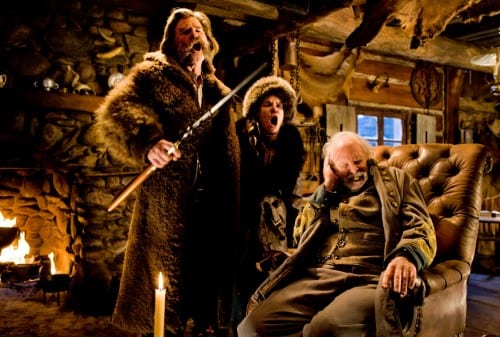 Whether you love Quentin Tarantino or you hate him — and let’s face it: Easy cases can be made on either side — you have to marvel at his gumption, if not his taste level or his judgment. He’s a self-confessed high school dropout and fanboy of genres that have never been high on the elites’ list of “respectable” cinema (chopsocky, blaxploitation, revenge melodramas), so by imitating them and adding his own flair, he forces audiences to reimagine them in a new light.
Whether you love Quentin Tarantino or you hate him — and let’s face it: Easy cases can be made on either side — you have to marvel at his gumption, if not his taste level or his judgment. He’s a self-confessed high school dropout and fanboy of genres that have never been high on the elites’ list of “respectable” cinema (chopsocky, blaxploitation, revenge melodramas), so by imitating them and adding his own flair, he forces audiences to reimagine them in a new light.
He’s also a child of technology, though, a director who’s fully aware of the old-time tricks and gimmicks of prior generations. Hence his decision to release his latest epic — the three-hour Western The Hateful Eight — in the Panavision 70 format, a lens and processing system not used in literally 50 years. The 70 mm lens show us breadth and scope, right? They turn the amazing vistas he’s able to capture into something magical and breathtaking, no doubt.
Well, not really.
In Tarantino’s hands, the use of Panavision 70 feels more like a gimmick than a mission, a way to draw attention to his nerdy love of wide screen formats that fell into disfavor, rather than to truly show us something new.
Indeed, the irony is, after the prologue that sets up The Hateful Eight — a stage coach ride that brings two bounty hunters (Samuel L. Jackson, Kurt Russell), a bandit (Jennifer Jason Leigh) and a would-be sheriff (Walt Goggin) to a remote outpost in the Wyoming winter — the film quickly devolves into a rather stodgy drawing-room murder mystery — as much Noel Coward and Agatha Christie as QT.
This isn’t entirely a bad thing; Tarantino grooves on retro riffs, so the stagebound, locked-room nature of the majority of the film keeps with that aesthetic. For instance, the introduction of virtually every character is met with another character recounting his resume — “I know you, you’re the famous bounty hunter/general/rebel/escaped slave who did such-and-so.” It’s talky, even ham-fisted exposition even for Tarantino, but it also has a grand theatricality.
In the second half — which comes after the intermission, if you see the roadshow version that includes overture, entr’acte and a few additional minutes (apparently) of snow-capped mountains — it goes for an And Then There Were None vibe: Who do you trust, and what’s really going on here? It explodes in a bloodbath eventually, as all Tarantino movies do, but not before QT adds his own voiceover (jarringly inappropriate) and some of the most misogynistic treatment of a female character onscreen this side of a snuff film.
The Hateful Eight is QT’s second Western in a row, following the whiz-bang success of Django Unchained. I won’t say I wasn’t consistently entertained by it, and left guessing at what was coming next. But there’s an indulgence factor that you can’t avoid in his films, a nudging elbow to the ribs that reminds you, “See what I did there? Cool, huh?” Yeah, cool, Quentin; how leave me alone to watch the damn movie.
Roadshow production opens Christmas Day; mainstream version will roll out in the coming weeks.















